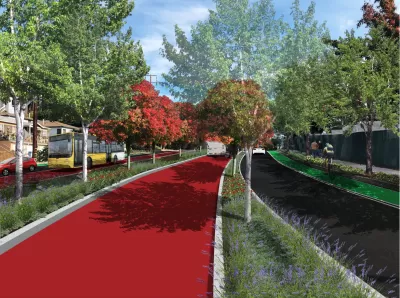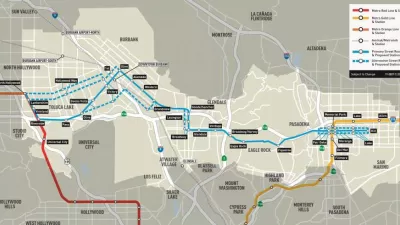The proposed changes to plans for a bus rapid transit route on Colorado Boulevard are an attempt to compromise between competing community concerns.

The Los Angeles County Metropolitan Transportation Authority (Metro) has revised its plans for a Bus Rapid Transit (BRT) line that will run from North Hollywood to Pasadena, writes Steven Sharp for Urbanize Los Angeles.
"The proposed route - bounded by an onramp to the SR-134 freeway in the east and Broadway in the west - includes the commercial core of Eagle Rock, which is centered on the intersection of Colorado and Eagle Rock Boulevards. Planning for the BRT line has been complicated by competing desires of local businesses, residents, and transportation activities to simultaneously maintain existing street parking, buffered bike lanes, and landscaped medians, while also accommodating future curb extensions and pedestrian safety projects along the corridor."
The segment of the line that would run through Eagle Rock has been controversial throughout the planning process. According to Streetsblog, "some of the initial community meetings held for the BRT Line were dominated by project opponents," who used "misleading social media posts and racist incidents targeting supporters" to create concerns about the project. "The Beautiful Boulevard Coalition, which launched in support of a street-running alternative, has sought to forge a compromise solution which addresses issues such as parking and landscaping, while sidestepping the complaints of opponents of the project as a whole."
In a presentation on March 16, Metro indicated that the agency has incorporated some of the suggestions made by the Beautiful Boulevard plan, including:
- converting one travel lane to BRT lanes in each direction east of Eagle Rock Boulevard
- retaining approximately 90 percent of street parking in Zone 2
- accommodating left turn pockets at select locations
Advocates believe the changes don't go far enough to protect pedestrians and cyclists and encourage public transit. "We should prioritize pedestrians and cyclists, rather than through traffic," said Q. Sarah Ostendorf, an advocate for the Beautiful Boulevard plan and faculty member at Occidental College. "Even though this project is meant supposedly to provide accessible, reliable transportation, [Metro's] first priority always seems to be cars."
Metro plans to announce the final design for the project in summer 2021.
FULL STORY: Metro tweaks its plans for BRT on Colorado Boulevard

Planetizen Federal Action Tracker
A weekly monitor of how Trump’s orders and actions are impacting planners and planning in America.

Maui's Vacation Rental Debate Turns Ugly
Verbal attacks, misinformation campaigns and fistfights plague a high-stakes debate to convert thousands of vacation rentals into long-term housing.

Restaurant Patios Were a Pandemic Win — Why Were They so Hard to Keep?
Social distancing requirements and changes in travel patterns prompted cities to pilot new uses for street and sidewalk space. Then it got complicated.

In California Battle of Housing vs. Environment, Housing Just Won
A new state law significantly limits the power of CEQA, an environmental review law that served as a powerful tool for blocking new development.

Boulder Eliminates Parking Minimums Citywide
Officials estimate the cost of building a single underground parking space at up to $100,000.

Orange County, Florida Adopts Largest US “Sprawl Repair” Code
The ‘Orange Code’ seeks to rectify decades of sprawl-inducing, car-oriented development.
Urban Design for Planners 1: Software Tools
This six-course series explores essential urban design concepts using open source software and equips planners with the tools they need to participate fully in the urban design process.
Planning for Universal Design
Learn the tools for implementing Universal Design in planning regulations.
Heyer Gruel & Associates PA
JM Goldson LLC
Custer County Colorado
City of Camden Redevelopment Agency
City of Astoria
Transportation Research & Education Center (TREC) at Portland State University
Jefferson Parish Government
Camden Redevelopment Agency
City of Claremont




























